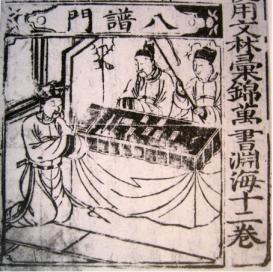Recently, historians of law, economy, literature, and art in China have become increasingly interested in daily life encyclopedia (lit. Complete Books of a Myriad Treasures 萬寶全書), a popular genre that emerged around the end of the sixteenth century. These sources were not elite learning and thus were rarely preserved in Chinese imperial libraries. Nevertheless, they do give precious insight into the mathematical, literary, and divinatory practices related to objects used in games of chance. Andrea Bréard focused in this project particularly on "ivory tiles" (yapai 牙牌), domino-like tiles with pairs of one to six dots represented on them. Her aim was to make explicit how these objects generated ideas and narratives. Combinatorial knowledge was used in determining the odds of the game of "ivory tiles," but the tiles are also closely related to divinatory practices or the players’ literary experience by "verses for use in drinking games" (jiuling 酒令). Drinking games, often played at banquets (youshang 侑觴), required the composition of poems that contained citations from vernacular novels, dramatic texts, popular songs, or the Confucian Classics and the names of domino combinations. She suggested that "ivory tiles" are meaningful objects, either when they stand alone, or in combinations of two, three, six, or eight tiles. They allow us to better understand the uses of mathematical knowledge in relation to the social and material context in which it is produced. By observing how mathematical knowledge, mainly known to the historian through literati sources, is incorporated into other bodies of knowledge—gaming, literature, and divination—we are forced to reconsider the dichotomy between elite and "popular" mathematical culture in late imperial China.

Title page of the "Chapter on Eight Treatises" containing a treatise on ivory tiles in A Vast Ocean of a Myriad of Books (Wanshu yuanhai 萬書淵海). Ed. by Xu Qilong 徐企龍, 1610.
Project
(2010-2011)
Games of Chance and Mathematical Knowledge in Late Ming and Qing China
- Andrea Bréard
